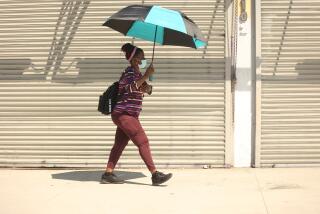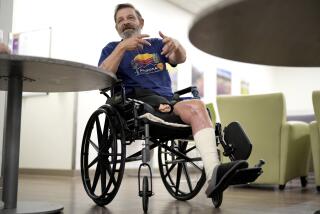Where to Find Inside Tips to Safely Enjoy the Great Outdoors
- Share via
While outdoor living is part of the California lifestyle year-round, the end of the school year and start of summer make us more active and take us outside a lot more. Biking, boating, hiking, swimming and picnicking all are staples of summer, but these activities come with some obvious (and not-so-obvious) risks.
Who wants to cook inside and heat up the house in the summer? Not I, so my family tends toward picnics, cookouts and takeout. But how do we keep food from spoiling, and do we really have to keep everything on ice? For some help, I went to the World Wide Web site managed by the Food Safety and Inspection Service, the public health agency of the U.S. Department of Agriculture.
At https://www.fsis.usda.gov/OA/pubs/foodtogo.htm, you’ll find advice on which foods should be kept in the picnic cooler and which ones can stay out (hard cheeses like cheddar and canned meats and fish don’t need to be in the cooler, for example). I also picked up a helpful picnic tip from the site: Keep beverages in one cooler and food in another. Beverage coolers are opened frequently, and you don’t want the food cooler to lose its cool.
*
I must confess that I was a sun worshiper during my teen years, smearing on the baby oil and setting up the sun reflector mats. I have recently begun to fully realize how much damage all those hours of sunbathing did to my skin. I’m now more cautious, especially during late spring and early summer, when the sun’s UV radiation is most intense in North America, according to skin cancer sites.
Think you already know about sun safety? It pays to make sure. I still see a lot of people applying sunscreen when they get to the beach or pool. That’s good, but did you know it’s better to slather it on before you leave the house? According to the American Academy of Dermatology (https://www.aad.org), it takes 20 minutes for the lotion to absorb and start protecting the skin.
After looking at this site, I decided to apply sunscreen to my kids before they put on their bathing suits. It’s actually easier to do and there’s less of a chance of missing critical spots. I was also reminded that certain prescription medications make people more sensitive to the sun, so ask your pharmacist about any summertime recommendations.
The dermatology organization is also a reliable resource for skin cancer prevention and detection information. Check out its “patient information” section, where a list of dermatologists offering free cancer screenings (including several in Southern California) is posted.
Look for the “Block the Sun, Not the Fun” campaign (located in the “skin cancer updates” section). The campaign, a joint effort of the dermatologist group and the maker of Coppertone sun-care products, provides information on skin protection for the whole family, including games for children that teach important tips. I found out that an estimated 80% of sun exposure over our lifetime occurs before age 18--about the time I was pouring on the baby oil.
Thank goodness those days of beautifully bronzed models are waning. Now, as this site points out, porcelain-skinned actress Nicole Kidman is on the cover of women’s magazines.
*
Even so, not everyone is getting the message. The incidence of skin cancer (malignant melanoma) doubled among whites between 1973 and 1994, according to the Centers for Disease Control and Prevention. And it’s the most common form of cancer among people ages 25-29. If it’s caught early, the cure rate is greater than 95%, but skin cancer can be fatal.
The CDC’s “Choose Your Cover” campaign, https://www.cdc.gov/chooseyourcover, is a skin cancer awareness program targeted mainly at youth. It promotes the use of sunscreen, hat, sunglasses, clothing and/or shade and recommends combining one or more of those precautions. There’s a question-and-answer section that explains the difference between the three types of ultraviolet rays and how sunscreen works.
The CDC site also includes a link to a UV index forecast for more than 50 cities. Or you can go directly to the site at https://www.cpc.ncep.noaa.gov/products/stratosphere/uv_index/bulletin.txt. The index calculates the risk factor for skin type II, which is a fair-skinned person who burns easily and doesn’t tan much.
While these public education campaigns suggest wearing long pants and shirts to guard against the sun’s damaging rays, I wonder how many of us would choose to do that during a midsummer heat wave. As for me, I’ll stick to the sunscreen and sunglasses.
Of course, fun in the sun also means water. The American Red Cross, responsible for certifying our nation’s lifeguards, offers water safety information for oceans, pools, boats and more at https://www.crossnet.org/hss/safety/water.html.
With advice from these sites, it shouldn’t be too difficult to avoid the perils of summer while still enjoying family vacations, barbecues and days at the beach.
*
Marla Bolotsky is managing editor and director of online information for the Henry J. Kaiser Family Foundation. She can be reached by e-mail at marla.bolotsky@latimes. com.
* Your Health Online runs every other Monday in Health.
More to Read
Sign up for The Wild
We’ll help you find the best places to hike, bike and run, as well as the perfect silent spots for meditation and yoga.
You may occasionally receive promotional content from the Los Angeles Times.






